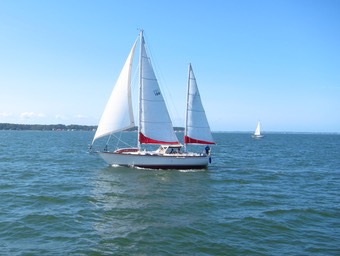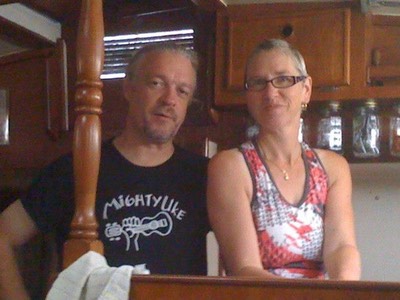We have a bilge pump counter. Over the last few weeks we’ve been severely worried about the counter being non-zero.
Non-zero bilge pump counter is a sure sign of a leak.
When we return to the boat and the counter is more than one, it's a sign of a fairly serious problem. The counter is a score for seriousness on a scale of 1 to anything over 3. A worrisome problem. Leaks are notoriously hard to find in the complicated plastic structure of a boat.
The main hatches drip. The hawsepipe (where the anchor chain goes below deck) drips. This doesn’t explain the bilge pump.
We had the hatches rebedded to reduce the dripping. We’ve larded some goo around the base of the hawsepipe escutcheon.
The rain on Wednesday 11/11 was epic. 24 hours of non-stop rain. Non. Stop. The newly rebedded hatches leaked. We found the leak by complaining to the folks who rebedded them. They sent a guy over. He noted the gaskets were old.
At first he told us to replace them. After he left, CA checked the work order for the hatch work. They was supposed to redo the gaskets when they rebedded the hatches. About the time CA was ready to lecture them on the work-order, the company owner called (apparently, they also checked the work order) and the gaskets will be redone as soon as it dries out some more.
Here’s what we saw.

Above my finger is a big wad of goo that holds the lens in. We never took a knife and cut away the overflow. The goo is sitting on a mottled gray aluminum frame.
There’s a line of black behind my finger. That’s the gasket.
There’s a thin line of white. Daylight.
Then there's the light gray lower part of the aluminum frame. A line of new, white bedding compound and finally, the interior teak frame. The black at the bottom is the rest of the boat, cast into shadow by the flash.
About that thin line of daylight. I put the gasket in about 10 years ago. It’s now hard as a rock and no longer fills the space. We (seriously) did not think to check this when it started dripping. (Perhaps we didn’t need to rebed the hatches, and we only needed gaskets. Lesson learned on diagnosis.)
But these are drips. Not enough water to trigger the bilge pump. They’re minor annoyances. When the float switch is high enough to start the pump, it’s gallons of water down there.
Some History
We cleaned the port side water tank earlier this summer. Then we filled it.
Then we switched to the starboard tank. We’ve been using that water for the last month or so. CA washed the entire deck this weekend using water from the starboard tank. (Winter is coming, might as well drain the tank doing something useful.)
So.
After deck washing, as expected, the starboard tank finally ran dry.
When it did, we switched to port. Which is clean. And waiting for us.
But.
Here’s the kicker
The port tank is empty. EMPTY.
Ah.
That explains the bilge pump counter.
The port tank was sort-of-fine until we washed it. Now it’s not fine. It leaked the entire 100 gallons into the bilge.
There are a few choices open to us. All messy.
- Try to find and plug the leak. The tank is at least 72″ long, 29″ wide, and 11″ tall. Most of the edges are inaccessible. The forward 36" of the tank is all that’s visible. Access to the interior is worse: the inspection ports are too small to do much.
- Replace the port tank with a new state-of-the-art plastic tank.
Also. The V-berth tank has always leaked. We’ve never used it. It’s probably time to tackle it, also. We want a “bow-shaped” tank. I’ll need to take some measurements up there, too.
Scott and Jeanie on Joie de Vivre replaced both under-the-floor tanks with a combination of new tanks giving them more water than the original setup.
I’m thinking of something less clever. The port tank is close to 120 gallons. If I’m willing to give up 20-30% of it, I think I can (relatively easily) drop four custom-made 28-ish gallon tanks into the space under the floor.
(The space under the old tanks needs to be cleaned and painted; then supports and straps are required. It isn’t trivial. The original tanks were assembled with the hull, making them a right pain to replace.)
The cabin sole opening is 34″ × 23″. The space inside the tank is closer to 35″ wide and 72″ long. This is 4 tanks, each about 34″ × 17.5″. Individually, they fit through the opening. Collectively, they mostly fill the space. It leaves a 4” gap between the forward pair and the aft pair. (It’s all about 11″ deep if you want to check the cubic inch to gallon measurements.)
I think I can (easily) build a four-way filler manifold that lays across the tops of all four tanks. A four-way vent manifold, similarly, will be needed. The four-way pickup manifold at the bottoms of all four tanks would be a wonderful thing.
I think some of the manufacturers will add an inspection port. What’s important is figuring out where the opening under the settee will be and trying to get two aft-most tank inspection ports somewhere near this spot. The two forward tanks are easy, since they’re entirely visible.
Scott reports that there’s space outboard of the original tanks that’s accessible. I think he used used 9″ tall tanks to make best use of the space. But they have to be slid in carefully and supported over the curve of the bilge. Utterly inaccessible under the settee. Not simple to install.
Next steps?
Maybe put some water in the tank to observe the leak? Not sure this really helps. It’s essentially impossible to plug unless we’re super lucky.
Still one more test might be good. Maybe we had the valves set wrong and pumped all the water out of BOTH port and starboard tanks. There’s a tiny chance that (a) the starboard tank doesn’t leak, and (b) the bilge pump running was pure coincidence. (If so, there’s an epic leak somewhere else. A leak that didn’t trigger the bilge pump during the 24 hours of rain on the 11th. This seems unlikely.)
After Thanksgiving, I need to get the DeWalt reciprocating saw (to go with my other DeWalt tools) and start cutting. It’s messy and loud, but — it appears — it’s got to be done. Then I can measure carefully and determine what tanks (and fittings) to buy. Then I can try to build and epoxy in some support framing. (This can be tricky to bond to the interior of the hull when it’s cold.)
That will make for a fun winter project.


